
If you want to learn about strength training without all the confusion, this guide to beginner’s strength training exercises is for you.
You’ve heard about all the life-changing rewards of strength training and the promise of a stronger, healthier body has got you thinking.
Maybe it’s time to give this whole lifting thing a try? After all, who wouldn’t want to be fitter, happier, and live longer? Not to mention empowered by strength and fat loss.
You’re ready – gym pass in hand – to take the leap.
But, you’re not quite one with the barbell yet and starting out in a loud, industrial factory sounding gym of experienced lifters still seems daunting.
Plus, you want to know exactly what you’re doing – no one wants to come across as the day one newbie.
Are we right? Save the sweat for your session later; we aren’t reading your mind right now. Everyone starts strength training in your shoes, so we know precisely how you’re feeling.
Luckily for you, years of research into lifting has already laid out the beginner’s blueprint. So, let’s get started with the best strength training exercises for beginners.
What is strength training?
Whenever we hear strength training, we typically imagine someone lifting weights.
It might be a strong, muscular hulk of a man dragging a double-bodyweight deadlift at the mercy of an arching, bending bar.
Maybe you see a professional athlete in the squat rack working through a complicated program – headphones on and laser-sharp focused.
The truth is, these scenarios are more for the serious specialist. Strength training is the simple idea of moving weight, then combining your movements with increasing intensity.
This is called employing progressive overload, a primary driver of musculoskeletal adaptations.
See strength training as the combination of movement with load. You’re even a load yourself because of the mass you carry, you don’t always need weights.
If you hit ten body squats right now, you’d be working toward strength training. Weights add a convenient way to challenge certain areas and increase how hard you must work. Go on, why not get started right away?
Why strength training?
Strength training isn’t just about getting stronger – it’s about improving almost every aspect of life. Health, happiness, and hormones can all be boosted by embracing lifting. The lean, powerful physique is also a plus.
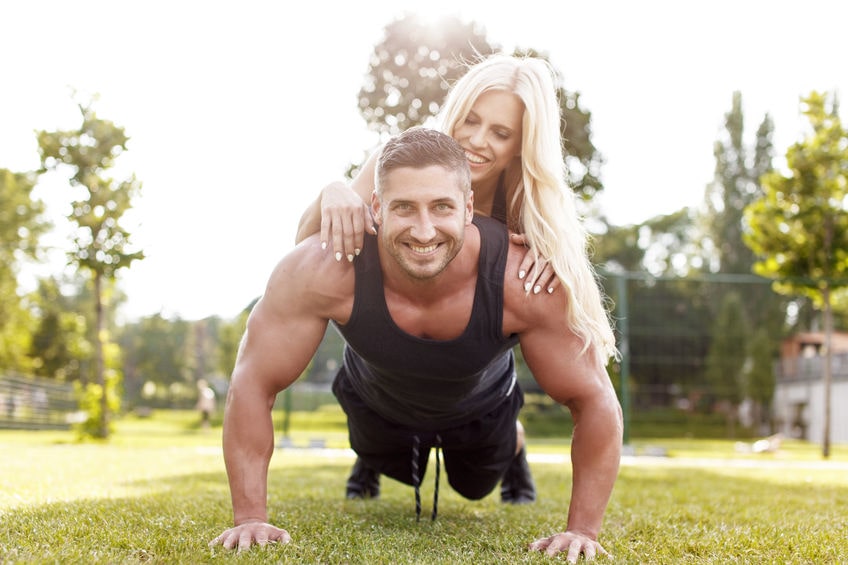
1. Muscular strength
It should come as no surprise that strength training makes muscles stronger[1].
After all, the clue’s in the name. But stronger muscles aren’t just for the gym. They make everyday activities like unloading the trunk or picking up your kids easier and safer.
Strength training is also shown to increase testosterone, a vital hormone responsible for muscle growth and fat loss[2][3][4][5].
Play a sport? Being stronger could elevate your game[6]. Getting a little older? Sarcopenia – aka muscle wastage – can be delayed[7].
It really is use it or lose it when muscle is involved.
2. Bone and connective tissue health
Strength training also holds some hidden secrets too. Not many people know it can increase bone density and connective tissue strength, making you less prone to injury[8][9].
You’ll be better prepared for whatever the world throws at you.
3. Live longer
Want to live forever – or just longer? Recent research suggests people who are weaker die younger, with overall strength being a key indicator of mortality[10].
Stay stronger to live longer, that’s our motto.
4. Stop obesity and lose weight
Plus, the simple act of lifting weights can burn fat both during and after a workout.
Muscle has a high energy demand compared to fat, meaning the more you have, the faster your metabolism (resting metabolic rate).
Constant calorie burning and lower obesity risk just from lifting? Count us in.
5. Healthier mind
Mental health is the talk of today, for good reason too.
How we feel about ourselves and our lives has a huge impact on our overall wellbeing, making looking after our mind just as important as our physique, if not more.
Who’d have thought lifting could help here too?
Strength training has been proven to help improve mental health markers; warding away depression, calming anxieties and creating a sense of empowerment[11][12].
Exercise is a great way to release energy, be in the moment, and prove to yourself just how powerful you really are.
What are the best strength training exercises for beginners?
By doing your research before striding out onto the gym floor you’re one step in front.
Starting out with advanced exercises or a pro bodybuilding workout lifted from a magazine is never a smart move, especially when the dreaded DOMS or injury kicks in.
But we’re with all the advice you need to stay safer.
Mastering these best beginner moves will give you a solid foundation to develop on for years to come.
Strength training is like building a house – first you set a faultless base; next you expand on top, again and again.
You’ll be setting yourself up for future success right from day one.
Feel free to turn this list into your own workout. Complete 8-15 reps of each exercise for three sets, around three to four times per week.
Rest as long as you need between each movement and choose a weight that’s challenging without compromising form.
Want to lose weight? Combine these exercises with a conservative calorie-controlled diet.
Here goes…
1. Bodyweight squat
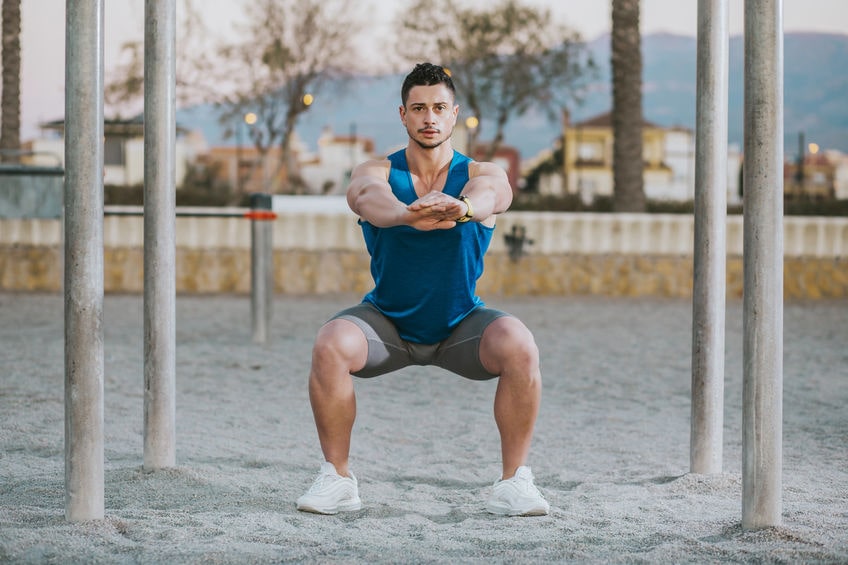
The bodyweight squat is an essential strength move for beginners. It tests almost your entire body and is step one to becoming a barbell squatting pro.
Because of the amount of muscles squats use, they’re a real calorie crusher.
- Stand with feet around shoulder with apart – point your toes out slightly around 10- to 20-degrees.
- Bring your chest up high and proud. Hold your arms out in front for balance (plus you can use them as a guide to see if your chest falls forward). Balance your weight evenly throughout your feet – think heels down.
- Push your hips back slightly, before lowering yourself into a squat with your knees. Letting the hips move first helps you to keep balance. Try to keep your knees on the outside of your big toe throughout the entire movement – this is important for keeping knees healthy.
- Descent low enough to make the squat challenging, but not too far so your form breaks down. Most people can get to a point where their hamstrings are parallel to the floor.
- Drive evenly through the midfoot to ascend back to the top. Keep your core braced and chest pushed out here. Your back should stay straight from start to finish.
2. Bodyweight push up
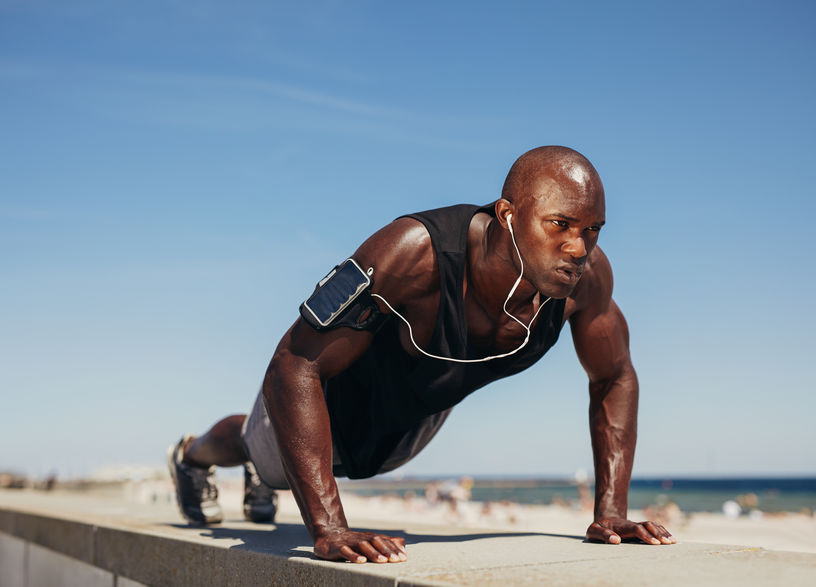
Learning the bodyweight pushup is the next step in your strength training progression.
Not only is it a staple for a strong upper body, but it’ll even give your glutes a squeeze.
Building proficiency in the pushup sets you up perfectly for handling heavier weights later.
- Set your hands flat on the floor directly under your shoulders. You can do this on all fours to make things easier.
- Next, take a step back with both feet until you’re in a top plank position. Try to make your body as straight as possible – think head, shoulders, and hips in line.
- Lower your chest to the ground while keeping tension in your back. Keep your elbows in toward you slightly at around 45-degrees and brace your core.
- Drive back through your palms to push your body back to the top in a straight line.
Tip: Fold a yoga mat and place it under your knees if you’re finding it tough to go from the feet. Follow all the same steps and simply let your knees be the pivot point.
3. Dumbbell row (single)

Sit around desk jockeying all day? The single-arm dumbbell row is for you!
It’s a great isolation exercise for working those tight lagging back muscles.
Plus, as a pull, it helps to balance out the front dominant push of the pushup.
- Place your knee on the bench and the same side hand out in front. Position your hand under your shoulder for support and brace your core.
- Reach down and pick up the dumbbell. Now, pull the dumbbell upward until your elbow is in line with your shoulder.
- Take a second to squeeze your back muscles.
- Lower the dumbbell back down under control. No need to put it on the floor, lower it to arm’s length until you’ve finished the set.
4. Triceps extension – kick back
[caption id="" align="aligncenter" width="800"] image credit: muscleandstrength.com[/caption]
image credit: muscleandstrength.com[/caption]
The triceps extension is the first isolation exercise on the list as it only uses one muscle group.
You’ll work the backs of your arms, making them better adapted to pushing, while simultaneously training your core to stay strong for support.
Grab a light dumbbell and let’s get to it.
- Stand with your feet hip-width apart. You’ll probably find this exercise easier with a narrower stance than your squat. Grab a dumbbell on the side you want to work.
- Push your butt back a touch and bend at your waist – lean forward.
- Pin your elbow into your side and bend your arm to 90-degrees. Now, using your triceps only, straighten your arm to arc the dumbbell behind you. Try not to use any momentum and embrace the burn.
- Reverse the movement until the dumbbell is back in the starting position. Take a deep breath and go again.
5. Bicep curl
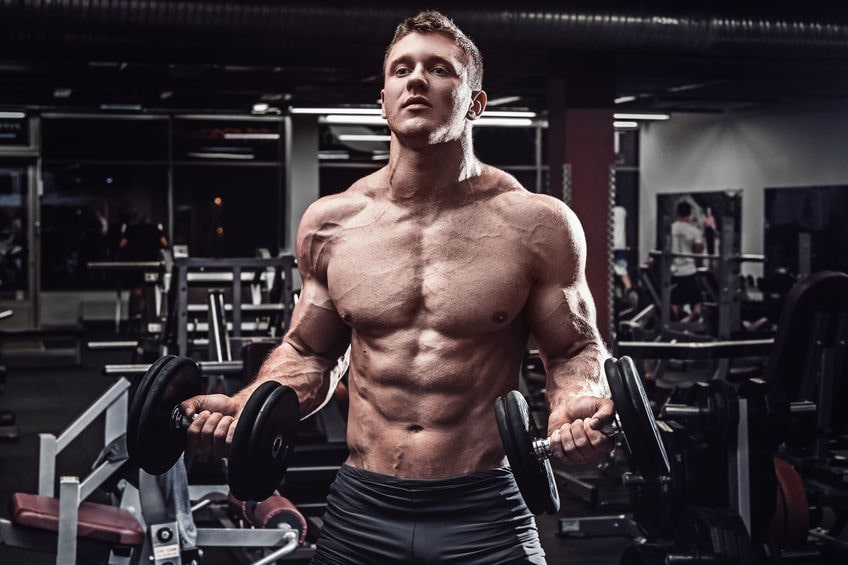
Muscle work in opposing pairs, with your bicep being the partner to your triceps.
When one muscle contracts, the other relaxes, which makes training both essential to maintaining a healthy, balanced body.
Remember how the triceps extension was all about preparing to push? You’re about to build opposing pull strength too. Pick up that dumbbell and let’s do this.
- Stand with feet hip-width apart again. Grad a dumbbell and let your arm fully extend, so the back of your hand is in front of your thighs.
- Pin your elbow into your side as you curl the dumbbell upward. Really concentrate on isolating your bicep and make it do all the work.
- Once the dumbbell is up top, slowly curl it back toward your thighs. You’ll feel it when you reach the top because your elbow will want to move away from your side – don’t let it. Stop here and lower the weight.
Tip: Momentum only cheats you out of solid reps and can slow your progress. Bracing your core can help keep you stable here.
6. Forward lunge
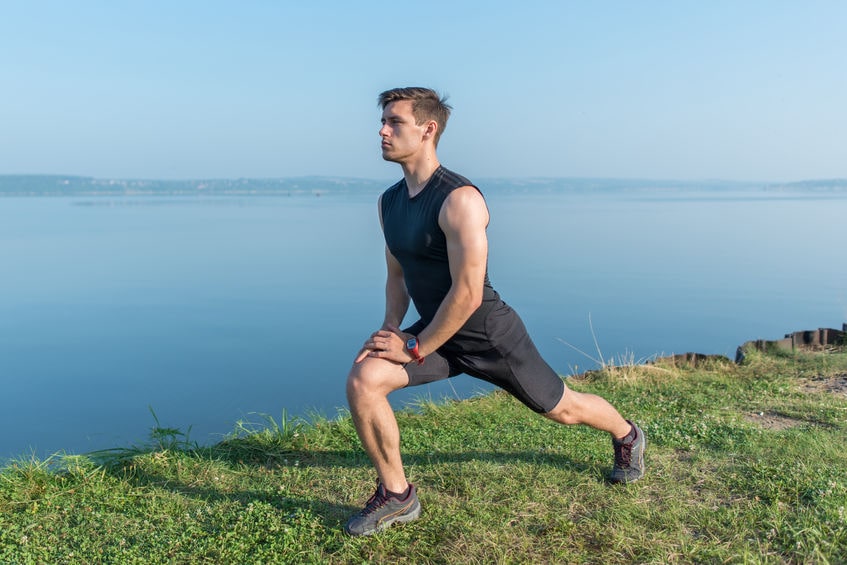
While the squat might seem harder on paper, we’ve saved the toughest till last.
The dynamics of the lunge gives your whole lower body a burn and really challenges your core to provide balance. Yes, even your abs and back get a workout with this one.
We suggest perfecting your form with just bodyweight before using dumbbells – trust us, it’s challenging enough to get started with. When you’re ready and confident, feel free to progress.
- Stand with your feet together at a comfortable width. Back straight, eyes facing forward.
- Stride out forward and lower yourself until both knees are at right angles. Imagine there’s a line going from your big toes right through your heel – make sure to keep the inside of the knee outside of this. Letting your knees cave inward can be bad for their health. Go for a shorter stride if you find it hard to control your knee line.
- Brace your core and keep a flat back as you lunge. Now, once at the bottom, drive through your front heel to push you back into the standing position.
- Repeat steps 2-3 on the same side or switch. Ensure you complete the same number of reps on each side to build a well-balanced, strong lower body.
The importance of progressive overload
Progressive overload forces your muscles work harder and creates positive changes inside them.
One of these adaptations is making you physically stronger, which explains why weightlifting is often called strength training too.
If you didn’t keep challenging yourself, you’d hit a level of strength and stay there. Progressive overload ensures you keep getting fitter and stronger, faster!
Pushing your body to new heights is also a great tool for weight loss.
If you were to complete the same workouts time and time again, your body would adapt to it.
After a while it’d no longer be difficult, which means you’d probably need less energy to complete it.
Keep challenging yourself, on the other hand, and you should continue to bag a decent calorie burn.
Similarly, you’ll carry on building muscle, which will speed up your metabolism and promote fat loss.
Look to progressively overload in small (<10%) increments around each week or so.
Don’t worry if you’re not ready to step up, it’s always better to stay safe and wait until you’re strong enough.
Take a de-load week every sixth week or so to allow recuperation.
You don’t have to completely stop strength training, just pull back the volume slightly and lower the load.
The bottom line
Starting strength training could improve almost every aspect of life. What you’re deciding to do will not only make you fitter and healthier, but potentially happier and stronger in mind too.
You can even take what you’ve learned today and get started right away.
Remember – everybody starts somewhere. Forget any loud lifters clogging up the free weights section, this is now your domain.
Start steady and use a journal to track your progress. It’ll ensure you’re using progressive overload and act as a great motivator over the years.
There’s nothing quite like looking back and seeing all your hard work in black and white.
Combine these exercises with a calorie-controlled diet if you want to lose weight.
Compound exercises usually burn extra calories compared to isolation moves, so make them the bulk of your workout. As always, get in touch if you have any questions – we’re with you every step of the way.
References
[1] https://www.jospt.org/doi/pdf/10.2519/jospt.1990.12.6.248
[2] https://link.springer.com/article/10.1007/BF00423247
[3] https://www.ncbi.nlm.nih.gov/pubmed/11915780
[4] https://www.ncbi.nlm.nih.gov/pubmed/17051372
[5] https://link.springer.com/article/10.1007/BF00423247
[6] https://pdfs.semanticscholar.org/a65d/d224600158a6086dcbd83281641c148e0f2f.pdf
[7] https://www.ncbi.nlm.nih.gov/pubmed/27374049
[8] https://www.ncbi.nlm.nih.gov/pmc/articles/PMC6279907/
[9]https://www.researchgate.net/publication/229797305_Connective_Tissue_and_Bone_Response_to_Strength_Training
[10] https://www.health.harvard.edu/staying-healthy/want-to-live-longer-and-better-strength-train




Leave a comment
“The best strength training exercises for beginners” are isolation exercises??? Nice!!!
Whoever wrote this article is either ignorant, high or developmentally challenged.
Hi Milan,
There are only two isolation exercises featured in this article. They can be used as accessories to support additional, more advanced upper-body movement patterns.
Thanks,
Greatest Physiques
Greatest Physiques